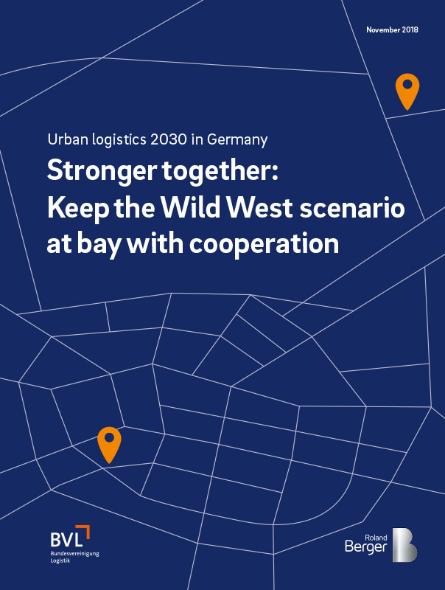What will urban logistics look like for Germany in the year 2030?
![{[downloads[language].preview]}](https://www.rolandberger.com/publications/publication_image/roland_berger_study_449_urban_logistics_cover_en_download_preview.jpg)
Along the two dimensions of regulation and cooperation, we produced a model with four distinct scenarios.



Urban logistics – defined as the flow of goods in urban areas – is not only fundamental to the supply of goods within our towns and cities, it is also central to the quality of life of the people who live there. As the rapidly growing scale of urban logistics increasingly brings into conflict the sometimes complex demands of different stakeholders (city authorities, logistics companies, retailers and citizens), the call for action is getting ever louder.

Four key trends influence urban logistics today. These are: urbanization, e-commerce, growing consumer demand for a faster and more individual delivery service, and retailers who are themselves placing orders for smaller quantities and expecting more flexible delivery. These trends have enormous consequences, and not just for the logistics industry – they also affect the people who live in our towns and cities, for instance increasing traffic congestion and reducing air quality.
The question cities face is how to make the evolution of urban logistics sustainable, and indeed, who will take the lead in this process. Will it be logistics companies or the city authorities themselves, or will it come down to close alignment between the private and public sector?
Seeking constructive ways to resolve these issues, this study, Urban Logistics 2030 in Germany, offers no simple solutions but outlines four scenarios that could occur as described or in a similar form.
Logistics providers in increasing numbers compete to win customers by coming up with innovative delivery concepts. Since commercial logistics is not a highly regulated field, innovative providers have no difficulty in entering the market.
The city defines and monitors a regulatory framework to manage urban logistics traffic more efficiently and reduce the volume of traffic on the roads. Strong competition between providers precludes cooperation and prevents the introduction of standards.
All urban delivery capacities run on a single platform operated either by the city or privately on the basis of a license. The platform pools the flow of goods across all providers and uses decentralized warehouses to optimize last mile deliveries.
A small number of large, competing platforms emerge that dominate urban logistics. With rising user numbers and an increased volume of deliveries, the platforms are able to pool logistics traffic more efficiently.
While the outlined scenarios illustrate the long-term perspective, we believe it's important to start laying the groundwork now in order to shape the urban logistics of 2030. It should be the shared aim of both city authorities and businesses to avoid a Wild West scenario, because abandoning all concept of network efficiency will bring a huge increase in urban traffic volumes coupled with further obstruction of the flow of traffic.
Some ways in which this could be done include taking steps within the city to create and approve a regulatory framework for urban logistics (regulated diversity), introducing integrated management of logistics traffic (city-wide platform) or promoting consolidation around a few platforms (coexistence of giants). In the interests of at least avoiding any further deterioration of quality of life in our growing cities, all stakeholders need to engage in or step up the dialogue. Find out more in our latest study.

![{[downloads[language].preview]}](https://www.rolandberger.com/publications/publication_image/roland_berger_study_449_urban_logistics_cover_en_download_preview.jpg)
Along the two dimensions of regulation and cooperation, we produced a model with four distinct scenarios.
